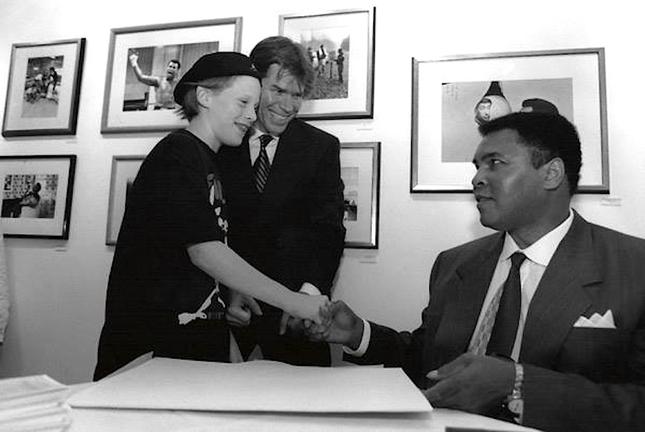The Night Muhammad Ali Came to Georgetown
By • June 8, 2016 0 1554

In 1995, the Govinda Gallery, for many years at 34th and Prospect and founded by Chris Murray, had already made a name for itself as a gallery that was as much about the photographic record of the pop culture and music of our times as it was about art.
It was marked by a series of high-profile photographic exhibitions that chronicled the history of pop and rock and roll — notably works by Annie Leibowitz and by Ron Wood of the Rolling Stones.
Nothing, however, has topped a night in early October 1995, when an exhibition of photographs by Howard L. Bingham from his book, “Muhammad Ali, A Thirty Year Journey,” was slated to open.
We knew it was a special night when we noted that Murray, the essence of cool informality, was wearing a jacket and tie. Bingham, Ali’s lifelong friend and chronicler, was scheduled to be there.
Bingham arrived for the opening. He had a friend with him: Muhammad Ali, The Champ, himself, self-styled “The Greatest.” Word had gotten out — lines popped up around the corner out onto Prospect Street, Georgetowners, city folk, neighbors, young and old, people who grew up with him. Many of them brought their children to see an over-sized person from history up close and personal.
Immediately, the night became electric. The Champ, then in his fifties, slowed by Parkinson’s Disease and quieter than any incarnation of the brash heavyweight champ from history, shook hands, and sat and signed copies of his book for what seemed like a very long time, but not enough of a long time. Murray brought his son David.
Ali may not have said much, but he was very much in the moment, alert, curious, intensely interested in his surroundings — and the people who approached him. He lit up noticeably whenever a youngster approached, all of them shy, their eyes big.
In this small Georgetown gallery, Ali filled the room easily, the way he filled auditoriums, stadiums, and sometimes far-flung countries in the course of championship battles against Joe Frazier and George Foreman.
By this time, Ali was already owned by history, something that went far beyond boxing and the sport he dominated for so long. When you met Ali that night, you confronted your own memories of him. You could see that energy and electricity in his eyes when he looked at you or at the gathered folks who filled Govinda Gallery to the brim.
The pictures on the wall were there to remind us, as if we needed reminders: the brash, youthful Cassius Clay, self-described as the “greatest” and “so pretty,” the fighter, the challenger of mores, the civil rights champion. In a time of celebrities of achievement, he could be in a room with Elvis or the Beatles and still be the center of attention.
We talked to Bingham a little, who said at the time: “Let me tell you about that man. He is for real. Oh, I suppose he was brash, as far as I can see, he never had much of a big ego. He’ll sign autographs for ever. He has integrity. For Afro-Americans, he was always a sign of hope, and kids especially would listen to him, they’d follow him everywhere, because that’s somebody they wanted to be like.”
Kids expected Ali to talk a lot, which he didn’t do. Bingham had a story about that: “He was signing autographs once and one of the kids said, ‘He can’t talk. Why isn’t he talking?’ Ali turned it on himself and said, ‘I’ve been talking and talking all my life. Maybe I’m just tired of talking.’ ”
It was a warm and balm Thursday night made warmer by the people packing the gallery. Television news reporters arrived, and cameras flashed. His head would lift up to cries of “Champ,” and he was a little stockier than Cassius Clay. But he had what he always had, an enormous presence that transcended hub-bub and ballyhoo. Everyone called him “Champ,” when they approached the table where he was signing books. They came a little like supplicants, awed. Ali did not speak but looked everyone in the eye and signed the books and posed for photographs, endlessly patient, immediately charismatic.
At one point, a man inched his way through the line with his son, a blonde-haired, pre-teen boy. Ali looked up and saw him standing there with small-boy shyness. His eyes lit up mega-watt sized in pure delight, as if he was once again in the ring, in the camera’s eye, the light’s glare, the exuberant embrace of fame. For that energy-filled moment, those truth-filled photos on the well and the man sitting at the table, merged, fused into one.
That’s the way I remember it, and that’s the way I wrote it then. It never got better than that. When the news came last week, it’s what I remembered first and again later. I remember now and today — the night Muhammad Ali came to Georgetown. Still The Champ. It was the greatest night, forever and a day.

